Guatemala confronts a dark chapter
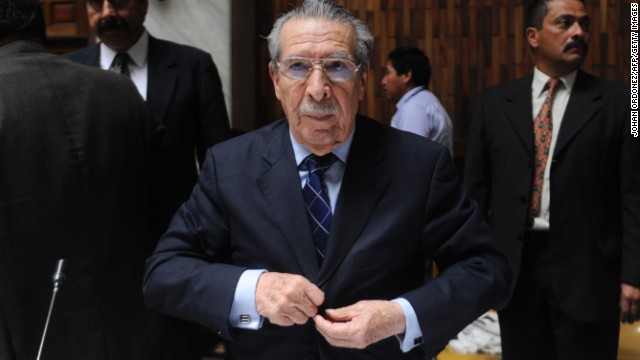
The soldiers killed Jacinto Lopez's teenage daughter Magdalena by repeatedly stabbing her in the neck.
Then they shot and killed his sons, 13-year-old Domingo and 10-year-old Pedro.
His in-laws were not spared. Barely anyone in the village was.
These atrocities, which took place in the remote Guatemalan town of Santa Maria Nebaj in July of 1982, have never been described in a courtroom.
Until now.
For the first time, Lopez has shared his terrifying story in the nation's highest court.
And for the first time "anywhere in the world," according to the United Nations, a former head of state is being tried for genocide by his own nation's justice system. That man is Efrain Rios Montt, an ex-military dictator who ruled Guatemala from 1982 to 1983.
"They killed my family and destroyed our crops," Lopez testified. "They took even my cows."
The attack against the Lopez family was just one of countless assaults in the early 1980s during the war between the Guatemalan government and leftist rebels.
The military used the rebel threat as a guise to exterminate rural Ixil Mayan villages accused of harboring insurgents, prosecutors say. According to prosecutors, the campaign led to the genocide of more than 1,700 Ixil Mayans.
Previous accusations of genocide, such as in Rwanda or against Serbia, have been presided over by international judges. The Guatemala attacks are considered by many experts as the only incident of genocide in the Western Hemisphere during the modern era.
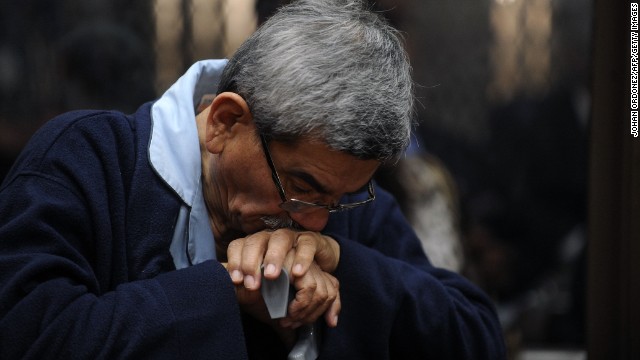
The trial reignites debate over the United States' controversial pro-government policies in the region during the 1980s. It also offers a fascinating look in real time at how a nation is choosing to face its own demons. Painful public testimony could help heal the national betrayal reflected in the faces of many Mayan victims.
Lopez, now 82 years old, is among dozens of witnesses who have testified at the trial being heard by the nation's three-judge Supreme Court.
Guatemala begins first genocide trial
Rios Montt, 86, is accused of authorizing a military strategy so brutal that it was labeled "scorched earth." His attorneys say the former dictator did not order any of the atrocities.
The genocide charges rest on the assertion that the army, under Rios Montt's orders, specifically targeted the Ixil because of their ethnicity, and not just because they were suspected of harboring rebels. The charge has been made before, but not in court. A 1999 report by a Guatemalan truth commission concluded that "agents of the state committed acts of genocide against groups of Mayan people."
During the opening remarks of the trial, an attorney for Rios Montt laid the foundation for the argument that no such ethnic targeting took place.
"I never heard a speech that said 'kill the Ixil, exterminate the Ixil,'" defense lawyer Francisco Garcia Gudiel said. Rios Montt "never gave an order, written or spoken, to exterminate a single Ixil in this country."
The United States stands accused in the court of public opinion. Critics say Washington turned a blind eye to the abuses, and worse. The Reagan administration claimed violence was decreasing during Rios Montt's tenure, and in 1983, lifted a U.S. arms embargo. But there are bookends for this dark chapter of Central American history. More recently, the United States has pushed for Guatemalan judicial reform that has made this trial possible
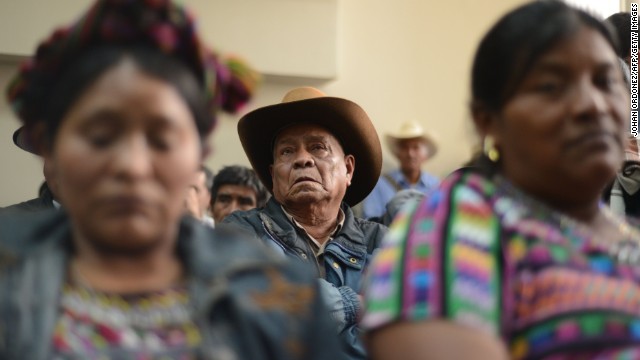
Horrific memories
For generations, the Ixil have lived in mountainous villages in the country's northwest, mostly isolated from the rest of Guatemala and the world. According to the country's 2002 census, Guatemalan Ixil number around 95,000, less than 1% of the nation's population.
They still speak primarily the Ixil language, and most of the witnesses called to the stand so far have spoken through a translator. The horrific stories that more than 70 prosecution witnesses have revealed so far have been hard to hear in any language.
"I was 12 years old," said one woman, whose identity was protected by the court. "They took me with the other women and they tied my feet and hands. They put a rag in my mouth ... and they started raping me ... I don't know how many took turns. ... I lost consciousness ... and the blood kept running. ... Later I couldn't even stand or urinate."
Stories about rape were so widespread that the trial set aside an entire day of testimony just for rape victims.
Their shocking stories prompted many of the hundreds of Guatemalans sitting in the courtroom to use their hands to cover their mouths. The powerful proceedings often wrapped the courtroom in profound silence, only to be broken by the sound of sobbing.
Pedro Chavez Brito was 6 or 7 years old when the military attacked his village in November 1982. Soldiers killed his mother, he told the court. In a frantic bid to escape, he hid with his pregnant sister and her two children among the family's chickens.
It didn't work.
When soldiers found them, they lashed Chavez's sister to the stairs of their home, he testified. The soldiers then set the house on fire, killing her and her two children, Chavez testified. Seven other family members may have died in the fire, he said.
Chavez, like many other survivors, lived to share his story because he fled into the unforgiving mountains.
That's how Maria Cruz Raymundo and her family escaped, too. But conditions there were so harsh that her husband, daughter and son starved to death, she told the court.
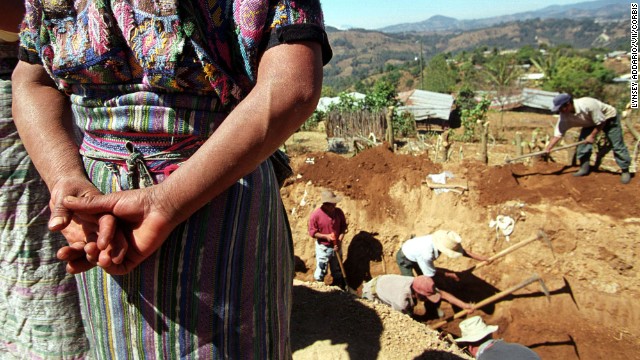
More than 100 witnesses have taken the stand so far -- a marathon of gruesome stories.
Another witness, Nicholas Bernal, testified that he, too, escaped to the mountains.
Bernal told the court he had watched soldiers kill his neighbors and then rip out their hearts and burn their bodies.
Each passing day of the trial reveals similar nightmarish stories. Human rights organizations such as the Center for Legal Action in Human Rights and Association for Justice and Reconciliation are broadcasting the trial live on the Internet. In addition, the U.S.-based Open Society Justice Initiative is providing daily summaries on a dedicated website. Testimony in this report is culled from all these sources and state news media.
Shifting U.S. behavior
When Rios Montt assumed power in a coup in 1982, Guatemala was already in the throes of a violent civil war that would last 36 years. The insurgency, and extrajudicial killings by the military, had been going on for two decades as part of the broader conflicts between leftist rebels and hardline governments across the region.
By the time a peace accord was reached in 1996, an estimated more than 200,000 had perished.
Photos: Searching for the 'disappeared' in Guatemala
Rios Montt faces charges of genocide and crimes against humanity connected to his 16 months as dictator. He is being tried together with his then-chief of military intelligence, Mauricio Rodriguez Sanchez.
Sanchez is accused of designing and executing the army's strategy.
When Rios Montt became president, human rights violations had already prompted the United States to cut off aid to the Guatemalan government. But a political scandal in the U.S. in the 1990s revealed that in fact the CIA continued to provide money to Guatemalan military intelligence sources for years during the civil war.
Now-declassified secret CIA cables indicate that the United States had knowledge of the atrocities being committed against the Ixil Mayans, but did little about them, according to Victoria Sanford, director of the Center for Human Rights & Peace Studies at the City University of New York.
"At best they chose to look away, but often they were covering it up," Sanford said.
In one CIA document, from February 1983, the agency reports to Washington that an increase in violence against civilians is because of "right-wing violence."
But the U.S. ambassador at the time added a note to the same memo with a distinct explanation: "I am firmly convinced that the violence described ... is government of Guatemala ordered and directed violence."
Another CIA memo shows the U.S. government may have had knowledge of the violent tactics being used against the Ixil Mayans.
"When an army patrol meets resistance and takes fire from a town or village it is assumed that the entire town is hostile and it is subsequently destroyed," the 1982 document states. "The well-documented belief by the army that the entire Ixil Indian population is (pro-rebel) has created a situation in which the army can be expected to give no quarter to combatants and non-combatants alike."
Critics blame the United States, in its anti-communist zeal, of standing by during these atrocities by denying them and lifting the arms embargo. Then-U.S. President Ronald Reagan went as far as to say that Rios Montt was being given a "bum rap" by critics. At the same time, the United States was backing other strongmen in Latin America against leftists.
But if the United States deserves criticism for openly supporting Rios Montt's rule, it also should be credited for supporting Guatemalan efforts to put the former dictator on trial, said Anita Isaacs, a professor of political science at Haverford College whose research focuses on Guatemalan politics.
She is a fierce critic of the U.S. role in the 1980s, but adds that "this trial wouldn't be occurring were it not for the role played by the United States pushing for reform in Guatemala's judicial system."
In her view, the U.S. ambassador to Guatemala from 2008 to 2011, Stephen McFarland, was "single-handedly" responsible for shifting the country's perception of the United States from meddling to supportive.
McFarland listened to survivors' stories of the civil war and attended hearings in support of the victims, she said.
The trial
The historic nature of the trial isn't lost on the nation's public, although some say too much time has passed for the process to be fair.
Even current President Otto Perez Molina, a former general who once commanded troops in the Ixil lands, has said he believes there was no genocide. Instead, some see the attacks as a kind of national defense campaign.
The Guatemalan military viewed the Ixil Mayans as rebel collaborators who threatened the government.

This view is shared by protesters with military ties who have stood outside the courthouse, holding signs demanding respect for the military and a fair trial. One demonstrator, Victor Manuel Argueta, told the state-run AGN news agency that the soldiers are "proud of what we did during the civil war."
The army in the early 1980s, he said, "was dedicated to defending the people from those who wanted to usurp power." The trial, he said, is nothing more than a "political lynching."
Declassified U.S. documents repeated the Guatemalan military's assertion that the Ixil were protecting the rebels.
But dozens of studies by anthropologists have indicated that it was much more complex than that, said Kate Doyle, director of the Guatemala Documentation Project at the National Security Archive, a leading research institute.
Some Ixil Mayans joined the guerrillas as combatants and others provided food or protection, but still others were not connected to the rebels. Some even actively opposed the rebels, she said.
Since the trial began, Rios Montt has fired his attorneys and then rehired them.
Defense attorneys have argued there's no evidence proving that Rios Montt ordered any of the abuses.
His lawyers have repeatedly and unsuccessfully demanded that the chief judge recuse herself. They say the judge violated Rios Montt's rights by pressing on with the trial when his attorneys were not prepared.
A victory, no matter the outcome?
The victims' stories are haunting, and the desire for justice strong, but the task of proving genocide isn't easy.
Prosecutors must prove the attacks targeted a specific ethnic group with the intention of destroying it, said Naomi Roht-Arriaza, a law professor at the University of California Hastings College of Law.
To convict Rios Montt, prosecutors must also convince the judges that he was responsible.
What's at stake is less clear. The genocide charges are without precedent. If Rios Montt and Rodriguez Sanchez are convicted, their maximum possible sentences are unknown.
In 2011, a Guatemalan court sentenced four soldiers to 6,060 years in prison each for their role in the 1982 massacre at Dos Erres, a village where 201 people were killed. Thirty years for each death. A fifth soldier was sentenced to the same last year. The unheard-of sentences were for crimes against humanity, not genocide.
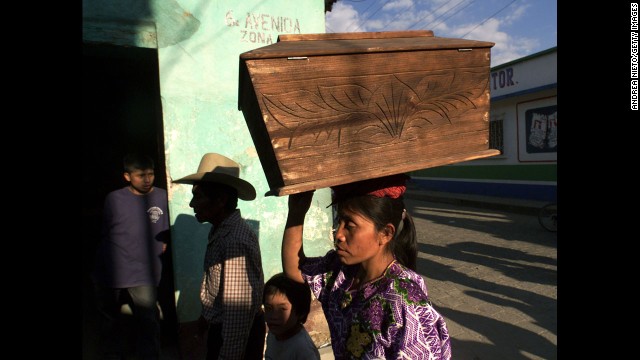
Given Rios Montt's age, many assume that he will serve little, if any, time in prison if convicted.
For the moment, legal observers say the trial itself stands as a huge triumph.
A national conversation
So many of the Ixil Mayans have described their ordeals using the same phrase: They said the army treated them "like animals."
These heart-wrenching revelations, said Roht-Arriaza, allow victims a very important opportunity.
Finally, they can acknowledge in a public courtroom the horrors they experienced so many years ago.
Several witnesses said they do not seek revenge, but simply want to be "liberated" by having their stories etched in the official record.
They must "make public what they may have kept inside," Roht-Arriaza said. "It opens up the nation to conversation. It lets people see that the justice system works."
Looking into the eyes of some of the victims in the courtroom, it's hard to know if they reflect pain or faith or peace -- or the relief of a weight lifted.
As the witnesses detail their horrifying stories, Rios Montt sits just a few feet away, expressionless. Listening.
As Isaacs put it, this "in itself is a form of justice."

